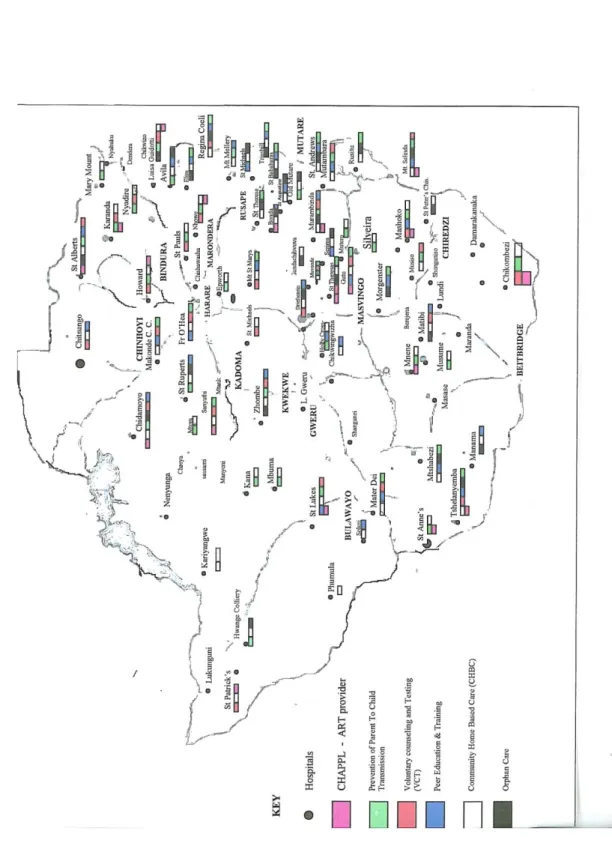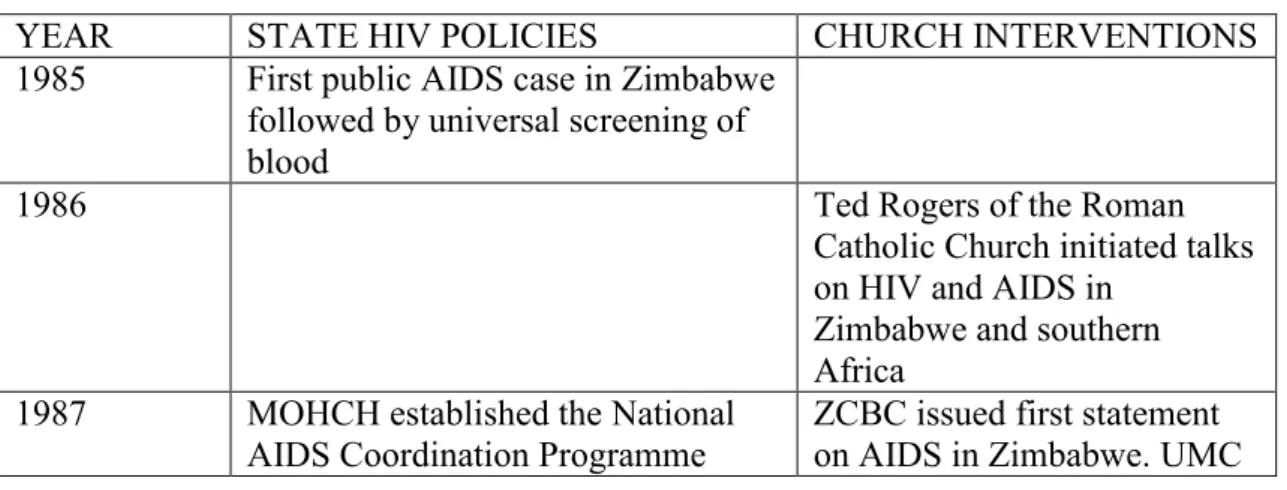This study focuses on the history of the response of the Roman Catholic, Anglican and United Methodist churches to HIV and AIDS in Manicaland Province, Zimbabwe between 1985 and 2005. s HIV and AIDS.
CHAPTER ONE
INTRODUCING THE STUDY
Introduction: Outlining the Task
A review of the AIDS scene in Zimbabwe in general indicates that after the first public case of HIV was recognized by the state in Zimbabwe in 1985.5 The crucial task of this study is to identify what the three churches or didn't do in response to the pandemic. The response of the churches in Zimbabwe cannot be separated from the way society has always responded to other previous epidemics.
The Research Question and Hypotheses
Rationale for the Study
The researcher is convinced that writing a history of the Roman Catholic, the Anglican and the United Methodist churches' HIV and AIDS interventions or lack thereof in Manicaland is a step forward in responding to the pandemic. It is hoped that other churches from within and outside the province, country, region, continent and the world as a whole will learn from this study.
Research Objectives
To find out what HIV prevention methods have been advocated by the Roman Catholic, Anglican and United Methodist churches in Manicaland between 1985 and 2007. To investigate what AIDS treatment measures were used by the Roman Catholic, Anglican churches and United Methodists in Manicaland between 1985 and 2007.
Theoretical Framework
As Ranger noted: ―In Southern Rhodesia, the pandemic gave a powerful impetus to the emergence of indigenous Christian prophetic churches—the Vapostori movements of Johane Maranke and Johane Masowe.‖43 This current research study brings a detailed analysis of the emergence to the fore. of a prophetic movement that claimed to cure HIV within the Anglican Church in Manicaland. Indeed, the church's response to HIV reflects the perceptions of the pandemic by its leaders and followers.
Literature Survey
- The History of HIV and AIDS in Africa
- The History of HIV and AIDS in Zimbabwe
- The History of HIV and AIDS in Manicaland
Mungwini, ―Shona womanhood: Rethinking social identities in the face of HIV and AIDS in Zimbabwe,‖ The Journal of Pan African Studies 2, 4 (June. Instead, the scope of the publication was to facilitate future responses to HIV and AIDS by the Anglican church in Manicaland.

Limitations and Delimitations of the Study
- Limitations of the Study
- The Delimitations of the Study
The main task of the current study is not to focus on church membership, but to holistically analyze responses to HIV and AIDS by these three churches. The Pentecostal Churches' response to HIV and AIDS appeared much later than that of the Roman Catholic, Anglican and United Methodist Churches in Manicaland in particular and Zimbabwe in general.
Research Methodology and Design
- Primary Oral Sources
- Data Analysis
Reports on the work of the Roman Catholic Church's diocesan project on HIV and AIDS were obtained from St. As a member of the Anglican Church in the Diocese of Manicaland since 1980, the researcher has been aware of this reality since the time Bishop Masuko retired in 1998. from the few interviews conducted by others, as acknowledged in the thesis, the researcher personally conducted the rest of the interviews.
By giving consent, the interviewer also authorized the use of the interview by the researcher and others thereafter.

The Structure of the Study
By introducing themes, the researcher was able to analyze the responses to HIV from each of the three churches separately and later conduct a comparative analysis. Coding of the data was carried out using markers and symbols to “further isolate different parts of the data as exemplary of or relevant to one or more…themes.”204 Themes were re-examined to ensure that parts of the text were further streamlined and therefore elaborated. Key focuses include an outline of the research, a statement of the research question and hypothesis, the outline of the study, a statement of the research question and hypothesis, the rationale for the research, and the research problem. goals.
The limitations and delimitation of the study will also be outlined and finally a chapter on methodology will be included.
This chapter will focus on important background issues. These include a discussion of AIDS in the context of other earlier epidemics, the African AIDS
While the state invited the churches to work with the government in the response to HIV and AIDS in 2000, further socio-economic decline was exacerbated by political upheaval. Between 2000 and 2007, the withdrawal of government donors meant that churches had to bear the burden of responding to the HIV pandemic. A review of the existing literature on HIV and AIDS in Africa, Zimbabwe and Manicaland will be analysed.
These include a discussion of AIDS in the context of other earlier epidemics, African AIDS.
In this chapter the research will focus on responses to HIV and AIDS by all the three churches in the middle period (1995-1999). The chapter will highlight
The last chapter forms the summary and conclusion of the study. It will pay attention to the effects of HIV and AIDS on church institutions, HIV and AIDS
CHAPTER TWO
THE HISTORICAL CONTEXT OF HIV AND AIDS IN ZIMBABWE
Introduction
AIDS in the Context of Other Earlier Epidemics
In Africa, sub-Saharan Africa is one of the regions most affected by HIV and AIDS, wiping out entire families and communities and leaving behind a trail of orphans. This research study will show that church leaders and lay members of the Roman Catholic, Anglican and United Methodist churches in Manicaland understood HIV and AIDS in moralistic terms. The apportionment of blame was not limited to the churches, but was also common among members of the general public.
The denial of the epidemic among certain classes of people during the time of the bubonic plague may have certain parallels with that of AIDS in Zimbabwe.
The AIDS Epidemics in sub-Saharan Africa
While the origins of HIV are beyond the scope of the current research study, Iliffe used the work of researchers including Luc Montagnier, Elizabeth Bailes et al., Nathan D. A review of the African AIDS epidemic by Iliffe shows that ―HIV-1 it first became an epidemic during the 1970s in western equatorial Africa, its home country. Condom use was found to be rare.‖259 While sex work has also been identified as one of the modes of HIV transmission in sub-Saharan African epidemics, this has less impact on HIV prevalence in southern Africa. .
Zimbabwe's government embraced the Millennium Development Goals, a United Nations initiative launched in 2001.
Overview of the State’s Responses to HIV and AIDS in Zimbabwe
- Brief Survey of State Policies and HIV Interventions
- The State’s Funding of HIV and AIDS Interventions
From 1985 onwards, the churches' responses to HIV and AIDS were not officially recognized by the state. Without the support of foreign donors, HIV and AIDS interventions under the state in Zimbabwe became quite minimal. The fund was intended to finance the operations of the National AIDS Council and key HIV and AIDS interventions.343.
Madzingira, ―The National AIDS Levy Trust,‖ SADC HIV and AIDS Best Practice Series (March 2008), 11,.
Brief Overview of AIDS-Related Home-Based Care in Zimbabwe
The emergence of home-based care in the context of the AIDS pandemic in Zimbabwe is a new phenomenon that has been associated with the ever-increasing number of people in need of care. The State identified AIDS-related home-based care to be a crucial intervention as stated in the National HIV/AIDS Policy for the Republic of Zimbabwe (December 1999).365 The general outlook indicates that some individuals, communities, churches, FBOs and NGOs entered the fray ahead of the state. As a result, little was known about their activities during the early years of the HIV epidemic, including the period 1987-1994.
The same period also saw increased WCC involvement in HIV interventions in Africa.

The Roman Catholic, Anglican and United Methodist Churches
- The Roman Catholic Church in Manicaland
- The Anglican Church in Manicaland
- The United Methodist Church in Manicaland
However, the committee's input was integral to the church's response to HIV and AIDS in Manicaland, Zimbabwe. The Anglican Church in Manicaland traces its origins to the work of George Knight-Bruce of the Diocese of Bloemfontein, South Africa. Lay and ordained delegates at the Church's annual conference debate issues critical to the life of the Church.
Mhondoro, private archives, Rusape, (AM), Official Journal of the Zimbabwe Annual Conference of the UMC third session, 2 January.
Synthesis
The study takes into account the state's national HIV and AIDS policy for the Republic of Zimbabwe, the introduction of the AIDS levy and the subsequent introduction of the National AIDS Council in 2000 as turning points for HIV interventions. The state's initiative to involve churches in the multisectoral response to the AIDS epidemic, as enshrined in the national HIV and AIDS policy, appears to have come late. Perhaps the government became aware that the churches had public influence and could play a positive or negative role in the response to HIV and AIDS.
In the case of Zimbabwe, there has been international pressure on the country to demonstrate transparency and accountability for donor-funded HIV and AIDS interventions, particularly since the late 1990s.
THE EARLY YEARS (1985-1994)
Introduction
The Roman Catholic Church’s Response to HIV and AIDS
- Edward T. Rogers: A Pioneer in the Response to HIV and AIDS
- Episcopal Statements on HIV and AIDS
- History of the Documents, Context and Reception
- Theological Rationale
- The Minority Positions
- The HIV and AIDS Commission is Launched
- Initiation of Home-Based and Orphan Care Interventions
- AIDS-Related Denial and Stigma at the Grassroots Level
Rogers became one of the church's first ministers involved in HIV and AIDS work in the mid-1980s. A few factors worked in favor of the church's early involvement in responding to HIV and AIDS. First, the Roman Catholic Church is not a newbie to public health care, which is why it took up HIV and AIDS as part of the church's social responsibility agenda.
At the national level, the initiatives of the Roman Catholic Church in the field of home care were among the first.
The Anglican Church’s Response to HIV and AIDS
- Delayed HIV and AIDS Interventions by the Leadership
- AIDS-Related Stigma and the Chalice
- Moral Rhetoric Undermines HIV Prevention
- Responses to HIV at the Grassroots Level
It also explored how Reverend Livingstone Nerwande's spiritual healing exploits might have been a manifestation of the church's denial of HIV and AIDS. Apparently, the leadership of the Anglican Church in Manicaland adopted a lukewarm approach to HIV and AIDS-related issues in the late 1980s, which was also echoed by Geoff Foster, founding director of FACT. This lack of interest in HIV and AIDS on the part of the clergy of the Church of England was also acknowledged by an internal source of the diocese.
Witchcraft is a phenomenon that most black Zimbabweans, including members of the Anglican Church, believe in.
The United Methodist Church’s Response to HIV and AIDS
- The Global Council of Bishops Engages with HIV and AIDS
HIV and AIDS gradually began to become an important issue for the leadership of the Church's annual conference in Zimbabwe later in 1989. The resolution on the use of condoms adopted at the Church's annual conference in December 1990 became an important milestone in the fight against the use of condoms. the history of HIV prevention. This may be one of the reasons for introducing a motion to legitimize the use of condoms, as decided at the church's annual conference session in 1991.
Church leadership and grassroots clergy rarely agreed on condom use.